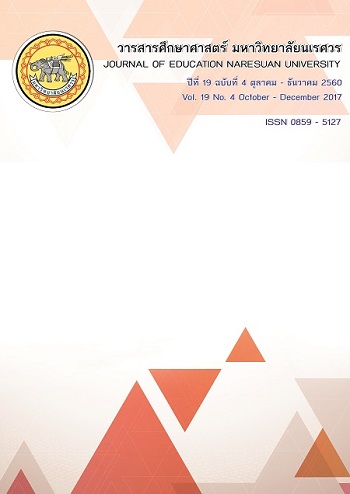USING RUBRICS TO IMPROVE TEACHING PERFORMANCE: A REVIEW OF RECENT LITERATURE
Main Article Content
Abstract
This paper presents an overview of the recent literature on rubrics as an improvement tool for teaching performance. Improving teaching and instruction is an item of the quality assurance system in Thailand's higher education institutions and appropriate processes or activities have to be reported in the post-teaching report (Mor Kor Or 5) for each course. Therefore, methods for improving teaching are outlined before the use of rubrics is analyzed and recent literature on the topic is discussed and commented. The goals of this paper demand the use of tools fostering formative assessment rather than summative assessment, so the application of descriptive rubrics is favored over the use of simple scoring rubrics, which actually represent rating scales or grading tables. Appropriate descriptive rubrics force the instructor to focus on the desired learning outcomes and not on the task or performance. 'Appropriate' means that the criteria to be assessed align to learning outcomes and not to the task itself. Another contribution of this paper is a meta-rubric for rubrics, which is of help when assessing formative descriptive rubrics.
Article Details
The owner of the article does not copy or violate any of its copyright. If any copyright infringement occurs or prosecution, in any case, the Editorial Board is not involved in all the rights to the owner of the article to be performed.
References
Brookfield, S. (1995). Becoming a critically reflective teacher. San Francisco: Jossey Bass.
Burnett, Rebecca E., Andy Frazee, Kathlyn Hanggi, & Amanda Madden. (2014). A programmatic Ecology of Assessment: Using a Common Rubrics to Evaluate Multimodal Processes and Artifacts. Computers and Composition, 31, 53-66.
Carbery, A., & S. Leahy. (2014). Evidence-based instruction: assessing student work using rubrics and citation analysis to inform instructional design. Journal of Information Literacy, 9, 74-90. http://dx.doi.org/10.11645/9.1.1980.
Dewey, J. (1933). How we think: a restatement of the relation of reflective thinking to the educative process. Boston: D.C. Heath.
Goldin, Ilyia M. (2011). A Focus on Content: The Use of Rubrics in Peer Review to Guide Students and Instructors (Doctoral dissertation). University of Pittsburgh.
Ito, Hiroshi. (2015). Is a rubric worth the time and effort? Conditions for success. International Journal of Learning, Teaching and Educational Research, 10(2), 32-45.
Jonassen, D. H. (2014). Assessing problem solving. In J. Michael Spector, M. David Merrill, Jan Elen, and M. J. Bishop (eds.): Handbook of Research on Educational Communications and Technology (4th ed.). New York.
Kegan, R. (1994). In over our Heads: the mental demands of modern life. Cambridge: Harvard University Press.
Kolb, David A. (1984). Experiential Learning: Experiment as a source of learning and development. Englewood Cliffs: Prentice-Hall.
Li, Jinrong, & Peggy Lindsey. (2015). Understanding variations between student and teacher application of rubrics. Assessing Writing. http://dx.doi.org/10.1016/j.asw.2015.07.003
Li, Alice L. M. (2016). Simulation-based clinical skill training to promote effective clinical learning with simulation evaluation rubrics in nursing education. International Journal of Information and Education Technology, 6(3), 237-242.
Lipnevich, Anastasiya A., Leigh N. McCallen, Katharine Pace Miles, & Jeffrey K. Smith. (2014). Mind the gap! Students use of exemplars and detailed rubrics as formative assessment. Instructional Science, 42, 539-559.
Luft, J. A. (1999). Rubrics: design and use in science teacher education. Journal of Science Teaching and Technology, 10, 107-121.
McGoldrick KimMarie, & Brian Peterson. (2013). Using rubrics in economics. International Review of Economics Education, 12, 33-47.
Manson, J. Russell, & Robert J. Olsen. (2010). Diagnostics and rubrics for assessing learning across the computational science curriculum. Journal of Computational Science, 1, 55-61.
Nordrum, Lene, Katherine Evans, & Magnus Gustafsson. (2013). Comparing student learning experiences of in-text commentary and rubric-articulated feedback: strategies for formative assessment. Assessment & Evaluation in Higher Education, 38(8), 919-940.
Panadero, Ernesto, Jesus Alonso Tapia, & Juan Antonio Huertas. (2012). Rubrics and self-assessment scripts effects on self-regulation, learning and self-efficacy in secondary education. Learning and Individual Differences, 22, 806-813.
Panadero, Ernesto, & Anders Jonsson. (2013). The use of scoring rubrics for formative assessment purposes revisited: a review. Educational Research Review, 9, 129-144.
Peeters, Michael J. (2015). Measuring rater judgments within learning assessments – Part 2: a mixed approach to creating rubrics. Currents in Pharmacy Teaching and Learning, 7, 662-668.
Rodgers, C. (2002). Defining reflection - another look at John Dewey and reflective thinking. Teachers College Record, 104(5), 842-866.
Rublee, Maria Rost. (2014). Rubrics in the political science classroom: packing a serious analytical punch. Political Science and Politics, 47(1), 199-203.
Schulman, L. S. (2004). Teaching as Community Property. San Francisco: Jossey Bass.
Simpson, Zach, & Tracey Morton McKay. (2013). Assessment rubrics: artefacts that speak in tongues? Per Linguam, 29(1), 15-32.
Smit, Robbert, & Thomas Birri. (2014). Assuring the quality of standards-oriented classroom assessment with rubrics for complex competencies. Studies in Educational Evaluation, 43, 5-13.
Walvoord, B. E. (1998). Effective Grading. San Francisco: Jossey Bass.
Zhang, Bo, & Jacob Misiak. (2015). Evaluating three grading methods in middle school science classrooms. Journal of Baltic Science Education, 14(2), 207-215.


